Cost-Effective Solutions with Used Skidder Parts in Forestry
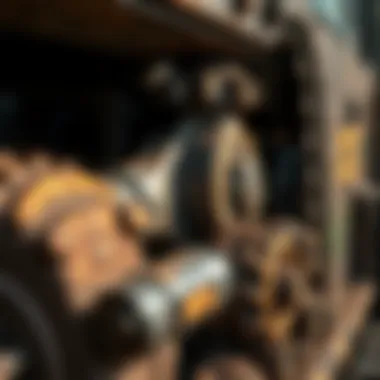
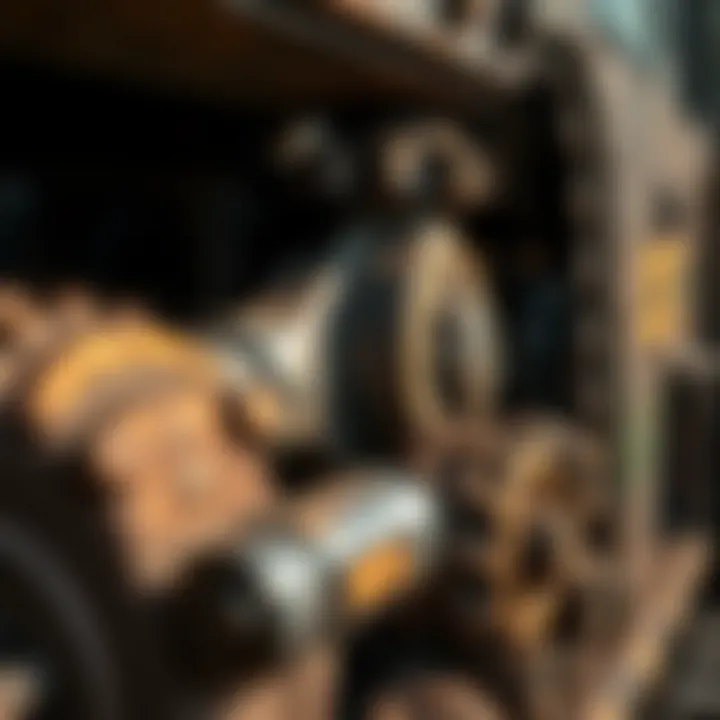
Intro
In the realm of modern forestry operations, the significance of equipment extends far beyond mere functionality; it embodies a philosophy of sustainability and cost-effectiveness. One key area that often merits further exploration is the utilization of used skidder parts. As these robust machines serve as workhorses in the timber and logging industries, understanding the advantages of repurposing their components is crucial for both economic and ecological landscapes.
This discussion is not just for seasoned forestry professionals but also for enthusiasts keen to delve into the intricacies of equipment maintenance. By examining the various facets of used skidder parts, from their definition to their real-world applications, we can garner insights that may redefine how we approach forestry operations.
Topic Overview
Definition and Importance
Used skidder parts refer to components salvaged from decommissioned or outdated skidder models. These parts, ranging from hydrostatic transmissions to differentials and axles, can be crucial in extending the lifespan of a skidder without the need to invest in brand-new replacements. In forestry, where machinery costs can significantly impact operational budgets, these used parts emerge as a viable solution to not only save money but also promote sustainable practices by reducing waste.
Embracing used skidder parts can lead to:
- Lower operational costs
- Fewer manufacturing resources needed
- Decreased environmental impact due to reduced waste
Brief History and Evolution
The concept of reusing machinery parts is as old as the machinery itself. Historically, skidders have undergone significant transformations, from early steam-powered models to today's advanced hydraulic systems. Over the decades, industries have recognized the potential of salvaged components, gradually building a thriving market for used parts. In fact, during financial downturns, many forestry companies have pivoted to sourcing used components out of financial necessity, paving the way for a trend that is now embraced even during boom periods.
"Repurposing isn't just a trend; it's a testament to ingenuity and resourcefulness in the forestry sector."
This shift towards used parts aligns with a broader industry movement towards sustainability and efficiency. As environmental regulations tighten and consumers become more conscious of their ecological footprint, the benefits of used skidder parts become increasingly compelling.
Through a detailed examination of the components involved, the practices surrounding their acquisition, and the long-term benefits of their integration into existing operations, this article will arm readers with the knowledge necessary to make informed decisions regarding the maintenance and application of used skidder parts.
Preamble to Skidders
In the intricate world of forestry, skidders represent a critical piece of equipment. These robust machines are engineered to maneuver logs from the dense forest floor to designated loading areas, playing an indispensable role in the harvesting process. Understanding the significance of skidders not only helps in appreciating their operational mechanics but also lays the groundwork for recognizing the value embedded in used skidder parts, which can substantially lower maintenance costs while promoting sustainable practices in the industry.
Skidders come in various types, each tailored to meet specific requirements of the forestry operation, from grapple skidders that pick up logs with a claw-like arm to cable skidders that rely on a winch system. Each variant boasts unique features and capabilities, making them suitable for different workloads and terrains. Understanding these distinctions is fundamental for any forestry professional looking to optimize their operations.
By exploring the components of skidders and the benefits of reusing parts, forestry operators can cultivate a more economically sound and environmentally friendly approach. Used parts can function effectively while significantly reducing waste. Not only does this practice benefit the budget of the operation, but it also serves a greater ecological purpose by prolonging the life cycle of existing resources, thus lessening the demand for new manufacturing.
The forestry industry is at a crossroad where sustainable practices must meet operational efficiency. Through a deep dive into skidder functionality and the case for reusing parts, we uncover pathways that intertwine cost-effective strategies with environmental responsibility.
This opening chapter sets the stage for a detailed examination of the workings of skidders, their historical journey, and the practical implications of utilizing used parts. All of these elements combined provide valuable insights for forestry professionals and enthusiasts alike, guiding informed decision-making in the field.
Understanding the Role of Skidders in Forestry
Skidders are the unsung heroes of forestry operations, serving as the vital link between logging and wood processing. They are designed to operate in challenging environments, where they grapple with the heavy lifting of timber while navigating uneven terrain. Their central role is to gather logs and transport them efficiently to loading docks or roadside, a daunting task that involves strength and precision.
Components of a typical skidder include a powerful engine, rugged tires, and a set of hydraulic systems that enhance maneuverability and load handling capabilities. The utilization of these machines optimizes time—allowing for greater productivity during harvesting seasons—while also minimizing the impact on the logging site itself.
The operational efficiency provided by skidders is particularly crucial in regions where weather conditions can shift quickly. For example, in damp areas, the compact design and traction capabilities can help reduce soil damage while still getting the job done effectively. These machines can be the difference between timely logging operations and costly delays, especially during peak seasons.
In reviewing the pivotal role of skidders, one quickly realizes that neglecting their maintenance, often due to avoidance of costs associated with new parts, can lead to operational setbacks. Here, the narrative for utilizing used skidder parts gains momentum, offering a viable alternative to expensive repairs while maintaining performance.
Historical Development of Skidders
The evolution of skidders is a story intertwined with the broader narrative of forestry practices. Early logging operations relied on manpower and rudimentary tools, a far cry from the mechanization we witness today. The first skidders, which surfaced in the mid-20th century, revolutionized how timber was harvested.
Initially built to enhance efficiency, these machines underwent continual refinements in terms of power, size, and functionality. Early models employed simple mechanical systems, yet gradually, technological advancements ushered in hydraulic systems, vastly improving load capacity and versatility.
Through time, skidders have been developed to adapt to various types of logging environments—what works well in a densely forested area may not suit an open field situation. As the market transformed, so did the machinery, evolving in response to the needs of forestry professionals who sought to maximize yield while minimizing ecological impact.
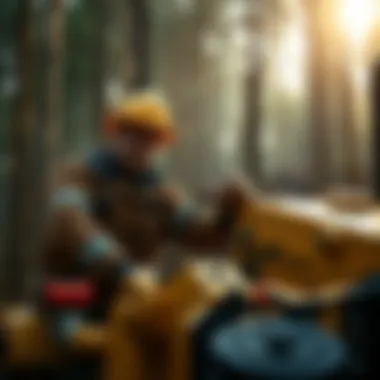

Keep in mind that as older models began to show wear and tear, the introduction of the used parts market sprang into existence, underscoring a trend toward sustainability and resourcefulness. Hence, the historical journey of skidders not only tells the tale of technological advancement but also sparks an important conversation on the implications of reusing parts in the modern forestry landscape.
Components of a Skidder
The components of a skidder are crucial to its overall functionality in forestry operations. Each part plays a role, meshing together to create a machine that performs efficiently under demanding conditions. When discussing used skidder parts, it is essential to understand how these components contribute to the machine's performance, and what benefits come from reusing them.
Engine and Transmission Systems
The engine is the heart of the skidder; without it, the machine simply cannot function. It dictates not only the power output required for heavy lifting and moving logs but also impacts fuel efficiency. When opting for used components, ensure that the engine has been well maintained. Look for signs of wear and tear, and consider the history of maintenance documents.
Equally important is the transmission system, which transmits power from the engine to the wheels. A faulty transmission can lead to poor handling and ultimately detrimental performance. Used transmission parts can offer significant savings compared to new ones. However, they must be carefully inspected, as a bad transmission can result in costly repairs down the line.
Chassis and Frame Structures
The chassis and frame provide the essential structure of the skidder, supporting the engine and all other components. A sturdy frame can withstand harsh forestry conditions like rocky terrains and heavy loads. Materials like steel or heavy-duty aluminum are common, so look for rust or deformation when acquiring used parts. It's vital to choose components that have not lost integrity through stress or damage; a compromised frame can lead to systemic failures.
Wheels and Traction Devices
Wheels are not just round pieces of rubber; they are critical for traction and mobility across various terrains. Skidders often use specialized wheels designed to handle uneven ground and slippery surfaces. When looking at used wheels, check for tread depth and signs of uneven wear. Properly functioning traction devices also contribute to effective load distribution across the skidder, enabling enhanced performance in challenging environments.
Hydraulic Systems
Hydraulic systems are indispensable in the functionality of skidders. They operate the winches, lifts, and other mechanisms critical to forestry operations. Used hydraulic components can provide an excellent return on investment if maintained properly. Oil leaks, corrosion, or a sluggish response can be indicators of underlying issues. Ensure that any used parts are rigorously tested for performance.
"Investing in used skidder parts can not only save costs but also promote sustainability in forestry practices."
Overall, understanding the individual components and their significance empowers forestry operators to make informed decisions about used parts. Reutilizing these components can lead to operational savings and contribute positively to sustainable forestry practices.
The Case for Used Skidder Parts
In the world of forestry operations, skidders are crucial machines that help move logs from the woods to the roads. However, maintaining a fleet of these machines can weigh heavily on a budget and the environment. This is where used skidder parts come into play. They offer an intriguing solution for operators looking to cut costs and support sustainable practices.
The case for used skidder parts is not just about saving a few bucks; it transcends to broader implications in operation efficiency and ecological considerations. Understanding the nuances of this decision can empower forestry professionals to make informed choices that reflect both economic sense and ecological wisdom.
Cost Benefits of Used Parts
When it comes to finances, forestry operations often find themselves between a rock and a hard place. New skidder parts can be prohibitively expensive, leading to careful budgeting. This is where used parts shine. By opting for second-hand components, operators can keep their machinery running without breaking the bank.
Key advantages include:
- Lower Initial Investment: Used parts typically come at a fraction of the price of new ones. This means more funds remain available for other critical operational expenses.
- Fast Turnaround: Finding used parts is often quicker than sourcing new ones, helping to minimize downtime.
- Budget Predictability: Operators can allocate resources more effectively, knowing that they can achieve maintenance without unexpected expenses.
Additionally, exploring different suppliers can yield even more cost benefits. Online marketplaces or local heavy equipment dealers often offer better deals than traditional manufacturers. Just like shopping at a vintage store, operators need to dig a little deeper, but the rewards can be substantial.
Environmental Impacts of Reusing Components
Beyond the dollar signs, there's an environmental angle that cannot be ignored. The forestry industry has come under scrutiny for its environmental footprint. By turning to used skidder parts, operators contribute to a cycle of reuse that benefits the planet.
Consider these environmental factors:
- Reduction in Waste: By choosing used components over new ones, the volume of discarded parts entering landfills decreases significantly. This aligns with the growing push towards a circular economy.
- Resource Conservation: Manufacturing new parts requires raw materials, energy, and water. Acquiring used parts means less demand for these resources and supports a more sustainable production process.
- Lower Carbon Footprint: Transporting new parts requires energy, contributing to greenhouse gas emissions. Utilizing local or readily available used parts can help reduce these impacts.
"In a world increasingly focused on sustainability, every choice leaves footprints, even the smallest one can lead to profound change."
Acquiring Used Skidder Parts
In the world of forestry operations, acquiring used skidder parts is more than just a cost-saving maneuver; it is a gateway to sustainable practices. As timber harvesting demands rise, equipment lifespans are tested, leading many to consider used components as viable alternatives. Understanding how to navigate the acquisition process is crucial, as it minimizes risks while maximizing benefits. This section explores the key aspects of acquiring used skidder parts, focusing on reliable sources, evaluation criteria, and strategic negotiations.
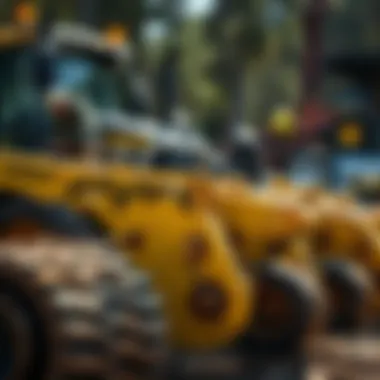
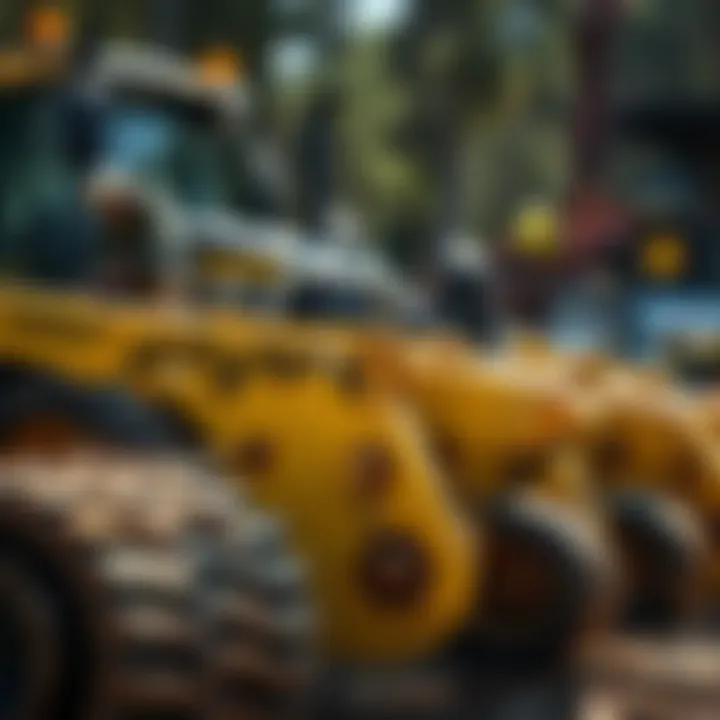
Identifying Reliable Sources
Finding trustworthy sources for used skidder parts is paramount. Without the right connections, the search can quickly head south. Here are several avenues to consider:
- Salvage Yards: Many offer specialized sections for forestry equipment. Make sure to visit these yards in person. Inspect the inventory and discuss any specific needs with the owner. Often, they can provide insights about the origin and history of components.
- Online Marketplaces: Platforms like eBay and Craigslist have a range of used parts from varying conditions. However, be cautious. Verify the seller's ratings and read reviews to avoid potential pitfalls.
- Industry Networks: Joining forums and community groups can lead to leads on reliable sellers. Websites like Reddit can provide first-hand experiences and recommendations from other forestry professionals.
“A word of mouth carries weight in the industry, don’t underestimate the power of personal referrals.”
These sources, when combined, create a solid foundation for finding quality skidder parts. Be prepared to invest time in researching, as it often pays off in the long run.
Evaluating the Condition of Parts
Once you've identified a potential source, the next step involves evaluating the condition of the used parts. In this stage, diligence is key. Here’s what to look for:
- Visual Inspection: Check for signs of wear and tear. Rust, cracks, or severe scratches can signify underlying issues. Pay attention to both external and internal surfaces when possible.
- Operational Tests: If feasible, test the components (like hydraulic systems) to assess functionality. A dealer or seller may allow you to operate the part, giving you a clearer picture of its capabilities.
- Documentation: Ask for maintenance logs or records that can give insight into how the part was used and cared for. This information can be invaluable when making a decision.
Keep a checklist handy during evaluations. It helps avoid forgetting crucial aspects that could impact performance and safety. Engaging with professionals who know the specifics of skidder parts can provide advice that’s been tried and tested.
Negotiating Prices and Terms
When you’ve narrowed down suitable options, navigating negotiations is the final step before acquisition. Here are some strategies:
- Know the Market Value: Before entering discussions, research what similar parts are selling for. Websites that specialize in used machinery often list prices for comparison.
- Be Transparent: If a part shows signs of wear, don’t shy away from pointing it out. This can set the stage for price adjustments.
- Package Deals: Look for opportunities to bundle parts. Suppliers might give a discount for a larger purchase, which can significantly reduce overall expenses.
- Payment Terms: Discuss payment options. Sometimes dealers might offer financing plans or layaway, especially for larger purchases.
Finding a good price while ensuring quality isn't just about the numbers—it's about building a rapport with the seller. Treat negotiations as a conversation rather than a confrontation for better outcomes.
Acquiring used skidder parts requires finesse and patience. However, the effort pays off by securing parts that not only save money but also contribute to sustainable forestry practices.
Maintenance Considerations for Used Parts
Taking care of used skidder parts may feel like a burden, but it’s actually a key strategy for extending the life of your equipment. Hitting the sweet spot between performance and sustainability is a priority for many forestry professionals. Proper maintenance practices not only ensure smooth operation but also help in avoiding costly replacements down the line. An attentive approach can lead to significant gains, transforming what could easily be perceived as a hassle into an opportunity for improved efficiency.
Effective maintenance embraces a range of practices that cater specifically to the unique needs of used components. Given the often-variable condition of these parts, it’s essential to recognize each piece's potential challenges. By building a strong maintenance routine, you can nip problems in the bud and maximize the functionality of each skidder part you acquire.
Routine Maintenance Practices
Regular maintenance is like oiling the gears of a clock; it keeps everything running without a hitch. This involves several essential steps, and if something seems off, it’s worth investigating further.
- Scheduled Inspections: Keep a written schedule for routine checks. Look at hydraulic systems, engines, and other major components to ensure everything is in working order.
- Fluid Checks: Engine oil, hydraulic fluid, and coolant levels should be checked at prescribed intervals. Dirty or low fluids can lead to premature wear.
- Part Cleaning: Debris and dirt can be your skidders’ worst enemies. Regularly clean parts to prevent clogging or corrosion.
- Replace Filters: Keep an eye on filters. Oil filters and hydraulic filters should be swapped out according to recommendations to maintain optimal performance.
"An hour of maintenance can save you days of repairs."
By maintaining a consistent routine, you extend not only the parts' lifespan but also ensure higher operational efficiency, saving both time and money in the long run.
Troubleshooting Common Issues
Caught in a bind? Understanding how to troubleshoot common issues with used skidder parts can often mean the difference between a minor fix and a major overhaul.
- Engine Doesn't Start: First, check the battery connections. Corrosion can sneak in and affect performance. If that’s not the issue, review the fuel system for clogs or leaks.
- Hydraulic Problems: If you find your skidder losing power, inspect the hydraulic lines for leaks or wear. Addressing these issues right away can prevent larger hydraulic system failures.
- Unusual Noises: Strange sounds can be an early warning sign of trouble. Investigate to determine where the noise is coming from. It might be a sign of loose bolts or possibly worn components.
- Uneven Wear on Tires: Tires should wear evenly for optimum traction. If you notice significant differences, it may indicate a misalignment or an issue with the chassis or suspension.
In addressing these common concerns, having a pragmatic mindset can make all the difference. It’s not about being perfect but about being proactive. Knowing what to look for paves the path for effective maintenance and smoother operations.
Operational Implications
Understanding the operational implications of using used skidder parts is crucial for forestry professionals. This section sheds light on how these components influence both the efficacy and safety of forestry operations. When systematic decisions are made regarding the integration of used parts into skidders, it leads to enhanced performance metrics and ensures that tasks are completed efficiently.
Impact on Skidder Performance


The performance of skidders, which are vital for transporting logs in forested areas, can be significantly influenced by the condition and quality of parts used. Components such as hydraulic lines and engine mounts, when sourced from reliable providers, can deliver performance levels akin to that of new parts. Moreover, older parts that have proven their durability can often be more reliable than new, untested components.
Some advantages of using used skidder parts include:
- Cost Reduction: Used parts typically come at a fraction of the cost, allowing for significant savings, especially during periods where budget constraints are tight.
- Maintenance of Equipment Efficiency: Well-maintained used parts can operate at their peak when fitted correctly, ensuring that skidders work efficiently without frequent breakdowns.
- Proven Performance: Many older parts have a track record showcasing their effectiveness in the field, giving operators peace of mind.
In addition, the integration of used parts often allows for faster repairs and less downtime on operations, which are crucial during timber harvesting seasons when every minute counts. By keeping the skidders in good working order with used parts, operators can maximize productivity, achieving more milestones within any given timeframe.
Safety Considerations in Using Used Parts
Utilizing used skidder parts is not without its own set of safety concerns. The potential for mechanical failures, if parts are not carefully evaluated, can lead to accidents which can jeopardize not just equipment but also the safety of the crew in the field. Therefore, a thorough inspection and assessment process becomes imperative when considering used components. Here are critical areas to focus on:
- Material Integrity: Ensure that the used parts don't display fatigue cracks or signs of wear. Components such as brakes and hydraulic lines play a vital role in overall safety.
- Compatibility: Parts should be compatible with the skidder model in use. Incompatibilities can lead to failures during operation, posing risks to operator safety.
- History of Use: Confirm the maintenance history of used parts. A previously mishandled or poorly maintained part might not uphold safety standards.
"Safety isn't just a priority; it's a fundamental aspect of operations that must never be overlooked."
Additionally, training staff on the proper checks to conduct during pre-operation inspections can mitigate safety risks associated with used parts. Promoting a culture of safety through rigorous checks helps in ensuring that used components do not compromise the integrity of forestry tasks. Ultimately, the longevity of both equipment and human resources relies on an unyielding commitment to safety standards, which can be sustained by the conscientious utilization of used skidder parts.
Future of Skidder Parts Reuse
The future of skidder parts reuse looms large in the realm of forestry, capturing the attention of a diverse range of stakeholders from tree farmers to conservationists. Continued focus on sustainable practices in forestry makes it increasingly vital to consider how salvaging, refurbishing, and reusing these components can play a pivotal role in operations while promoting long-term resilience for our forests.
The necessity to shift toward more sustainable models within the forestry industry feeds directly into the conversation about used skidder parts. As resource scarcity of traditional materials continues to be a growing concern, used parts offer a practical solution. They not only mitigate costs but also lessen environmental footprint by extending the life of components, ensuring that valuable resources are not prematurely discarded.
Furthermore, the integration of used parts can lead to improved procurement practices, helping forestry professionals to think outside the box when sourcing their equipment. It shifts the mindset from a single-use or throwaway culture to one that emphasizes circular economy principles, where parts are brought back into production cycles. Whatever way you slice it, the benefits of reusing skidder parts resonate widely and powerfully in a contemporary forestry operation.
Emerging Technologies in Component Reuse
The emergence of new technologies is significantly shaping how used skidder parts are procured, assessed, and utilized. Advanced modeling software and data analytics have started to play a key role in determining the compatibility and viability of used components. These technologies not only aid in precise evaluations but also streamline the acquisition process.
Additionally, innovative innovations such as 3D printing are allowing for rapid prototyping and production of components that might be hard to find. Spare parts that once required lengthy lead times can now sometimes be fabricated on-site, reducing downtime.
Moreover, companies are increasingly harnessing machine learning algorithms to predict potential failures in used parts, which enables operators to undertake proactive maintenance while minimizing risks associated with equipment malfunctions. This approach improves overall efficiency and helps maintain safety standards in operations, thereby giving a major boost to productivity. Addressing those technological advancements will not only change the game but will also reinforce the sustainability dialogue in the long run.
Trends in Sustainable Forestry Practices
The conversation surrounding sustainable forestry practices increasingly embraces the significance of reusing components, particularly in the context of skidders. It is important to recognize how intertwined the concepts of sustainability and economic viability are. As the demand for ethically sourced timber rises, forestry operations must adapt by integrating used parts into their systems and embracing environmentally friendly methods.
Several ongoing trends manifest this shift:
- Circular Practices: Many organizations are adopting circular models in their operations, reducing waste and enhancing resource efficiency by reusing parts.
- Eco-certifications: Entities in forestry are seeking certifications from authoritative bodies that endorse sustainable practices, which increasingly demand the use of repurposed materials.
- Societal Pressure: With rising public awareness around environmental issues, consumers are more inclined to support companies and products that demonstrate a commitment to sustainability.
- Regulatory Frameworks: Local and regional regulations are beginning to encourage or mandate the adoption of sustainable practices, including the reuse of skidder parts.
End and Recommendations
Utilizing used skidder parts in forestry operations presents a myriad of advantages that cannot be overlooked. The insights gathered throughout this article indicate that not only can these components contribute significantly to cost savings, but they also play a pivotal role in promoting sustainability within the industry. By allowing for a broader scope of maintenance practices and financially accessible solutions, they pave the way for greater operational efficiency.
Furthermore, understanding how to responsibly source these used parts ensures that the environmental impacts are minimized. Careful evaluation of suppliers and adherence to quality standards not only safeguards the equipment's performance but also enhances the overall safety of forestry operations. By keeping in mind the implications of potentially poor sourcing, operations can avoid the pitfalls that come with subpar components.
As we draw conclusions, it is evident that there’s a pressing need to foster a culture of responsible sourcing and operation. Forest management strategies increasingly demand solutions that prioritize sustainability while also addressing practical concerns such as cost-effectiveness and equipment longevity.
Summary of Key Insights
- Used skidder parts can significantly reduce financial expenditure in forestry operations, offering a more cost-effective alternative to new components.
- The environmental advantages realized through reusing skidder parts contribute positively to sustainable forestry practices, aligning with global push for eco-friendly solutions.
- It is crucial for forestry professionals to identify reputable sources for used parts, ensuring they procure components that meet safety and performance standards.
- Regular maintenance practices tailored to used components can extend the life of skidders, further enhancing operational efficiency.
Encouraging Responsible Sourcing Practices
Creating a responsible sourcing framework for acquiring used skidder parts is key to safeguarding not just the functionality of machinery but also the ethics surrounding forestry practices. Here are several steps and considerations to guide professionals:
- Research Suppliers: Start by identifying reliable suppliers with established reputations within the industry. Gather reviews and testimonials to assess their track record.
- Consult Local Networks: Engage with other forestry operators or local communities involved in forestry work. They can provide recommendations for trustworthy sources.
- Inspect Parts Thoroughly: Never take a seller’s word at face value. Inspect used parts yourself whenever possible. Look for signs of wear and tear, and request maintenance records.
- Certifications and Standards: Make sure that the parts meet necessary certifications and industry standards, as this can reduce the risk of operational failures caused by inferior components.
- Build Relationships: Establish long-lasting partnerships with suppliers who prioritize quality and transparency in their business practices. A strong relationship can lead to better deals and more reliable service.
Responsible sourcing doesn't just save money; it fosters a healthier environment and supports local economies.
By adhering to these principles, forestry operations can protect their investments and contribute to the longevity and sustainability of not just their own equipment but also the forests they operate within.



